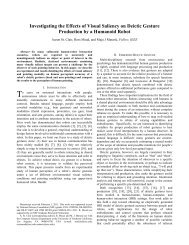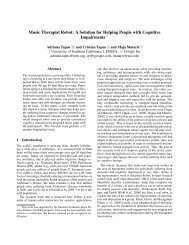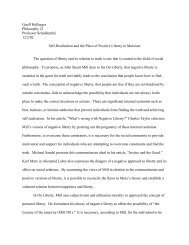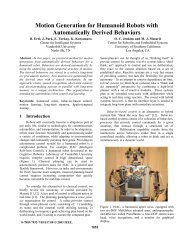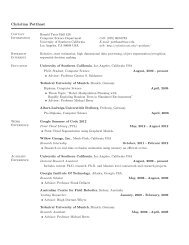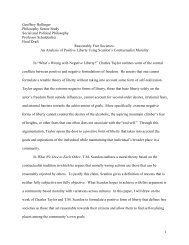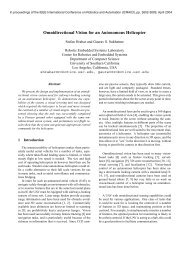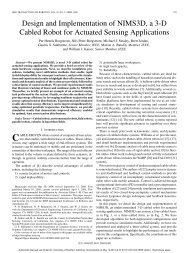A Socially Assistive Robot Exercise Coach for the Elderly
A Socially Assistive Robot Exercise Coach for the Elderly
A Socially Assistive Robot Exercise Coach for the Elderly
You also want an ePaper? Increase the reach of your titles
YUMPU automatically turns print PDFs into web optimized ePapers that Google loves.
2. Related Work2.1 <strong>Robot</strong>s <strong>for</strong> <strong>the</strong> <strong>Elderly</strong>Fasola & Matarić. A SAR <strong>Exercise</strong> <strong>Coach</strong> <strong>for</strong> <strong>the</strong> <strong>Elderly</strong>The literature that addresses assistive robotics intended <strong>for</strong> and evaluated by <strong>the</strong> elderly islimited but growing. Representative work in <strong>the</strong> field includes robots that focus onproviding assistance <strong>for</strong> functional needs, such as mobility aids and navigational guides.Dubowsky et al. (2000) developed a robotic cane/walker device designed to helpindividuals by functioning as a mobility aid that provides physical support <strong>for</strong> walking aswell as guidance and health monitoring of a user’s basic vital signs. Montemerlo, Pineau,Thrun, and Varma (2002) designed and pilot-tested a robot that escorts elderlyindividuals in an assisted living facility, reminds <strong>the</strong>m of <strong>the</strong>ir scheduled appointments,and provides in<strong>for</strong>mational content such as wea<strong>the</strong>r <strong>for</strong>ecasts.Researchers have also investigated <strong>the</strong> use of robots to help address <strong>the</strong> social andemotional needs of <strong>the</strong> elderly, including reducing depression and increasing socialinteraction with peers. Wada, Shibata, Saito, and Tanie (2002) studied <strong>the</strong> psychologicaleffects of a seal robot, Paro, which was used to engage seniors at a day service center.The study found that Paro, always accompanied by a human handler, was able toconsistently improve <strong>the</strong> moods of elderly participants who spent time petting andengaging with it over <strong>the</strong> course of a 6-week period. Kidd, Taggart, and Turkle (2006)used Paro in ano<strong>the</strong>r study that found it to be useful as a catalyst <strong>for</strong> social interaction.They observed that seniors who participated with <strong>the</strong> robot in a group were more likely tointeract socially with each o<strong>the</strong>r when <strong>the</strong> robot was present and powered on, ra<strong>the</strong>r thanwhen it was powered off or absent.Perhaps <strong>the</strong> robotic system <strong>for</strong> <strong>the</strong> elderly most related to our SAR exercise system is<strong>the</strong> work of Matsusaka, Fujii, Okano, and Hara (2009), who developed an exercisedemonstrator robot, TAIZO, to aid human demonstrators during simple arm exerciseswith a training group. However, this robot was not autonomous, as it was controlled viakey input or voice by <strong>the</strong> lead human demonstrator, and it did not have sensors by whichto perceive <strong>the</strong> users; hence, it did not provide any real-time feedback, active guidance, orpersonalized training.2.2 Social Agent <strong>Coach</strong>esSocial agents that aim to assist individuals in health-related tasks such as physicalexercise have also been developed in <strong>the</strong> human-computer interaction (HCI) community.Bickmore and Picard (2005) developed a computer-based virtual relational agent thatserved as a daily exercise advisor by engaging <strong>the</strong> user in conversation and providingeducational in<strong>for</strong>mation about walking <strong>for</strong> exercise, asking about <strong>the</strong> user’s daily activitylevels, tracking user progress over time while giving feedback, and engaging <strong>the</strong> user inrelational dialogue. Kidd and Breazeal (2008) developed a table-top robot to serve as adaily weight-loss advisor; it engaged users through a touch-screen interface, tracked userprogress and <strong>the</strong> state of <strong>the</strong> user-robot relationship over time, and was tested in a sixweekfield study with participants at home. French, Tyamagundlu, Siewiorek, Smailagic,and Ding (2008) designed and explored <strong>the</strong> use of a virtual coach to assist manualwheelchair drivers by providing advice and guidance to help users avoid hazardous <strong>for</strong>msof locomotion.These systems are similar to our SAR exercise system in <strong>the</strong> manner in which <strong>the</strong>yprovide feedback (from a social agent) and, with <strong>the</strong> exception of French’s work, in <strong>the</strong>activity being monitored (physical exercise). However, our system is clearly distinct in3



